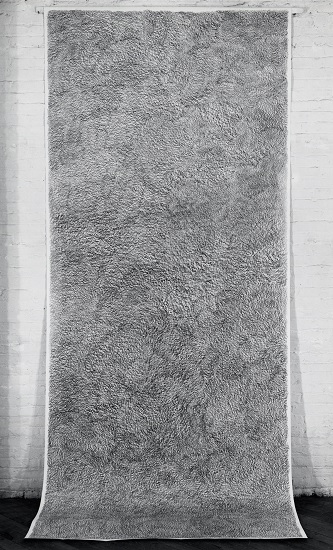
Michelle Stuart
American, 1933-
#5 Moray Hill, NY, 1973
graphite on muslin-backed rag paper
142 x 62 in.
SBMA, Museum Purchase, Contemporary Art Acquisition Fund, General Art Acquisition Fund, and Anonymous Donor
2016.3

“In order to execute the idea, you need a certain material that is going to allow you to do what you’re challenged to do in your imagination. You should use whatever you can and it’s amazing how even if you change the medium, your work is still yours.”
- Michelle Stuart’s Mythologies, Interview Magazine, Feb. 5, 2016
COMMENTS
The earth’s physicality has fascinated Michelle Stuart since childhood. Her work often examines landscape as both a metaphor for memory and the sense of place we seek as human beings. Like other artists associated with the movement known as Land art, Stuart has investigated sties as a symbolic abstraction – a concept she understood well from her work as a cartographer in the mid-1960s. Her piece “#28 Moray Hill” challenges traditional ideas of drawing and its boundaries by combining performative gestures with found materials.
This large, scrolling sheet of paper is scaled to the body and extends down the wall, creating a dimensional presence and invoking actual terrain, as if one might enter into it. Through size, proportion and shape, the artist alludes to the way in which we inhabit the landscape. The title refers to the location where Stuart found the rocks and earth, which she then used as both a medium and a drawing instrument. Using muslin-backed paper allowed her to aggressively smash these materials into the sheet without tearing it. This technique resulted in a pitted surface, indexing the site used to make the piece, while mimicking dirt and earth more generally. Stuart added aluminum powder to create a sheen, so the work’s visual qualities change depending on lighting and viewing angle. This drawing is part of a group of related works that Stuart created in a similar format using the same special paper, all of which reveal her experimental approaches to materials and process while referencing the earth both literally and metaphorically.
© 2015, Whitney Museum of American Art, Handbook of the Collection, p. 373
SBMA CURATORIAL LABELS
Since the late 1960s, Michelle Stuart has become recognized for a rich and diverse body of work engendered by her lifelong interest in the natural world and the cosmos. In the 1970s she created a monumental series of drawings with rolls of paper unfurled over areas of earth. Over the surface of the paper she would smash rocks and deposit soil, rubbing it into the paper. These, along with other drawings and sculptures engaging the land and incorporating natural materials, would lead to her inclusion in the international movement known as Land art.
#5 Moray Hill is among the artist’s iconic scroll works that utilizes graphite to record traces of the landscape. Produced early in the artist’s career in upstate New York, the scroll consists of muslin-backed paper that she placed over the ground before producing a rubbing that recorded its intricate details. Stuart’s development of this method was informed by the Surrealist technique of frottage (taking paper rubbings from surfaces) and influenced by a number of the artist’s own interests in anthropology, topography, mythology, history, and scientific imagery.
- Summer Nocturne, 2018
